With Direct plans in mutual funds gaining popularity in recent years, investors are getting inclined towards low-cost investing.
(Also Read: Invest in Direct Plans, the financial planning way)
To reduce the cost of investment even further, investors have started shifting towards passive investing or investing in the index itself rather than going with an active strategy trying to outperform the index.
The cost is low because the fund manager has to just replicate the index and generate market returns, without involving much research and analysis of the company financials. In this article, we have explained index funds in detail.
Yet another category, which is emerging gradually is Smart Beta Funds or Smart Beta ETFs. These funds serve as a middle ground between active and passive investment strategies, neither 100% active nor 100% passive.
It’s like a Fund Manager puts his Stock selection Strategy in a formula and automates the selection process. So active thoughts are put into Passive funds.
The idea is to give the investor a chance to beat the broader markets in the long-run of course, yet keeping the cost of investment lower than the active counterparts.
In this post let us understand what exactly are Smart Beta strategies and is this the ‘new age’ way of investing? Let us find out.
What is smart beta?
As you may know, Beta is the measure of market volatility (price movements) represented by an index, just like Standard deviation. However Standard deviation represents the volatility as compared to the average returns of the fund, Beta is in comparison to the fund’s Index or Benchmark.
(Also Read: How Mutual Fund Benchmarks help you select the Right Fund)
Beta of 1 means the fund’s volatility is equal to that of Index.
Now, beta becomes ‘smart’ when the index is tweaked keeping in mind some strategy, so that a better risk-reward ratio i.e. higher returns and/or lower volatility (than the index) in other words, alpha could be achieved.
Smart Beta strategies aim to tweak the weightage of stocks in the index which is primarily based upon market capitalization, on the characteristics or factors which the fund manager feels could outperform the index or a combination of them, such as-
- Lower volatility i.e. giving higher weightage to low volatile stocks,
- Value i.e. good stocks available at a cheaper price,
- Growth i.e. those stocks having high growth potential are given a higher weightage,
- Quality i.e. companies having a quality business are given a higher weightage etc.
What these Smart Beta ETFs do is that they backtest these factors or a combination of those with the help of computer programming and take the help of machine learning to manage the model, eliminating human biases.
These funds are not dependent on the Feelings of the fund manager or you may say it ignores the Qualitative Factors which a fund house may be following up in the other actively managed funds, and only Quantitative factors are considered in designing the portfolio.
Some Smart Beta ETF Indices available in India:
Here are some of the Smart Beta ETF (factor-based) Indices available in India:
- Nifty 50 Value 20 (NV20): This index consists of the 20 most value-oriented companies out of Nifty, selected on the basis of price to earnings (PE), Price to Book (PB), Dividend Yield and Return on Capital Employed (RoCE).
In this strategy, out of the top 50 companies traded on the NSE, 20 stocks with low PE (30% weight), Low PB (20% weight), High Dividend Yield (10% weight), and High RoCE (40% weight) are shortlisted. The list is reviewed annually and compliance check is done on a quarterly basis. You may know the detailed strategy here.
- Nifty 100 Low Volatility 30: In this strategy, out of the top 100 stocks traded on the NSE, 30 least volatile stocks of the last one year, based on the daily price returns are selected.
- Nifty 100 Quality 30: In this index top 30 companies from the parent Nifty 100 index, with higher profitability (Return on Equity), lower leverage (Debt/Equity Ratio), and more stable earnings i.e. Earnings per share are selected. It is rebalanced semi-annually.
- Nifty 50 Equal Weight: In this strategy, all stocks of the Nifty 50 are assigned equal weights (2% each) rather than the conventional market cap based weighing strategy. You may read more on the strategy in the NSE White Paper.
- Nifty 100 Equal Weight: This is also similar to the Nifty 50 Equal Weight strategy. The only difference is that it also includes the constituents of the Nifty Next 50 index, i.e. top 100 stocks traded on the NSE.
Below table shows the weighing strategy of these Smart beta indices:
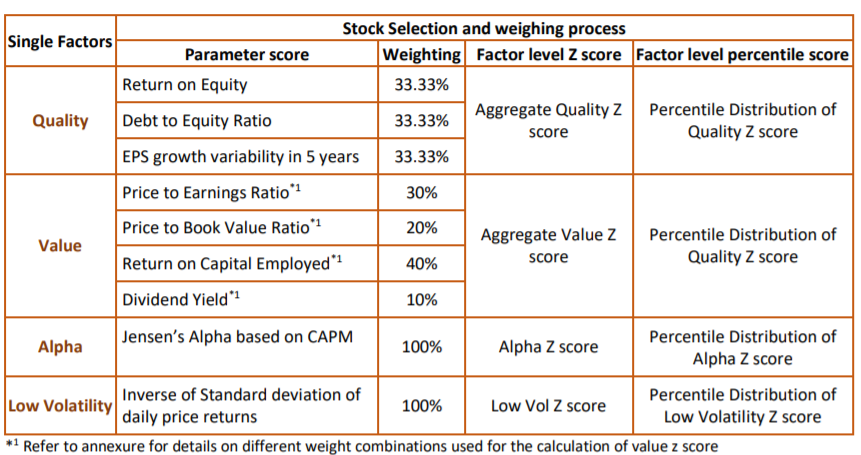
Apart from these, there are some multi-factor indices as well, which combine 2 or more factors to filter out stocks from the parent index. Currently, there are only 4 multi-factor indices:

Smart Beta Funds/ETF list:
Most of the Smart Beta investments are available in ETF Structure, few funds are also there, here’s the list of some of them:
Smart Beta ETFs:
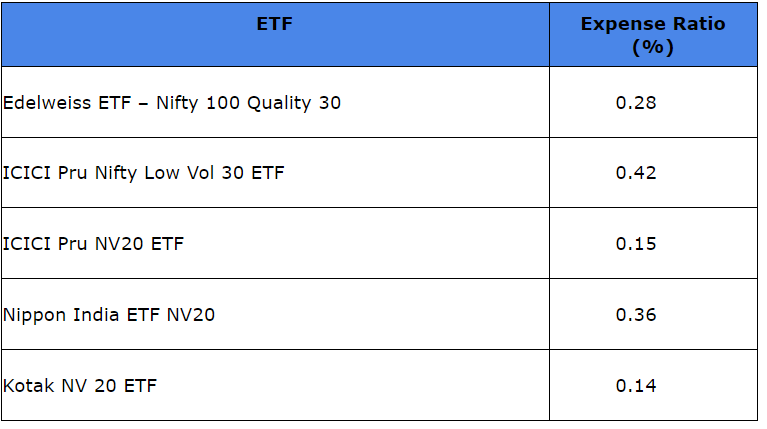
Smart Beta Funds:
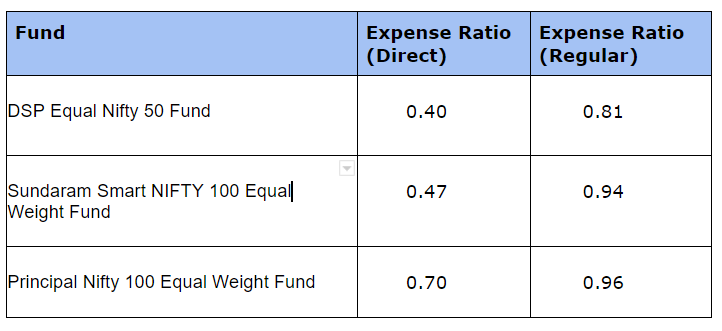
Smart Beta ETF Performance Comparison:
Let us compare the past performance of these smart beta Funds/ETFs over 3 years and see which strategy has outperformed the Broad Benchmark.
To compare the performances, we have considered the growth of 10K (lump-sum) invested in the index and the smart Beta Funds/ETFs:
3 year Performance comparison of DSP Equal Weight Nifty 50, Kotak NV20, and ICICI Pru Low Vol 30 with Nifty:
In the above graph,
- The orange line represents the performance of Kotak NV20 ETF
- The Green Line represents the main Index i.e. Nifty
- The Blue line above the Green is ICICI Low Vol 30 performance &
- The Blue line below the Green one is DSP Equal-Weight performance; over a 3 years horizon.
3-year Performance comparison of Edelweiss Nifty 100 Quality 30, Principal Nifty 100 equal weight, and Sundaram Smart Nifty 100 Equal Weight with Nifty 100:
In the above graph,
- The Green Line represents the main Index i.e. Nifty 100
- The Blue line above the Green is Edelweiss Nifty 100 Quality 30 performance &
- The Blue line below the Green one is Principal Nifty 100 Equal-Weight performance
- The Orange line shows Sundaram Smart Nifty 100 Equal-Weight performance; over a three years horizon.
It is clearly evident from the above past Performance graphs that only Nifty Value 20 and Nifty Low Volatility 30 smart beta strategies have outperformed Nifty and Quality 30 has outperformed Nifty 100 for the period December 2017- December 2020.
Smart Beta Funds India: Pros and Cons:
Smart Beta Funds/ ETFs provide the investor an opportunity to reap the benefits of Active Investing in a passive structure. The cost of investing is also significantly lower than the Active funds, especially in the ETF structure.
These ETFs provide a diversification advantage as the portfolio is spread across different sectors of the economy and thereby minimizing risks as well. Also, some strategies have beaten the index over the long term horizon. Elimination of human bias is also an advantage.
But, it is also true that not all strategies have outperformed the index. Equal Weight Strategy, For instance, has shown a massive underperformance than the index.
Also, some strategies may prove to be riskier due to the concentrated portfolios, which may increase the volatility. Nifty Value 20, for example.
Liquidity is also a big concern in ETFs. You may not find a buyer when you need to sell your investments in the ETF structure. SIP facility is also not available and one should have a Demat account to invest in ETFs, which can be a disadvantage for some.
The Expense Ratio is also a bit higher than those of the plain vanilla index funds. Read more on expense ratio here.
Smart Beta Funds: Should you invest?
Smart Beta is a new concept, slowly gaining traction in India. Most of these Funds/ETFs have less than a 5-year track record. Performance-wise also only 2 options look convincing. Concerns of ETF structure also prevail.
Also, for many investors, these strategies can be complex and difficult to understand. It would not be wise to get into any investment just by looking at past performance and low cost, without having at least a basic idea about the same.
(Also Read: 5 ways to review Mutual Fund Portfolio)
So, as of now, it is too early to comment on whether one should consider Smart Beta Funds as a part of their investment portfolio or not. We should wait and watch this segment and track the performances of these Funds/ ETFs very closely before making any decision.
Also Check: ESG Funds: What’s so special about this investment theme?



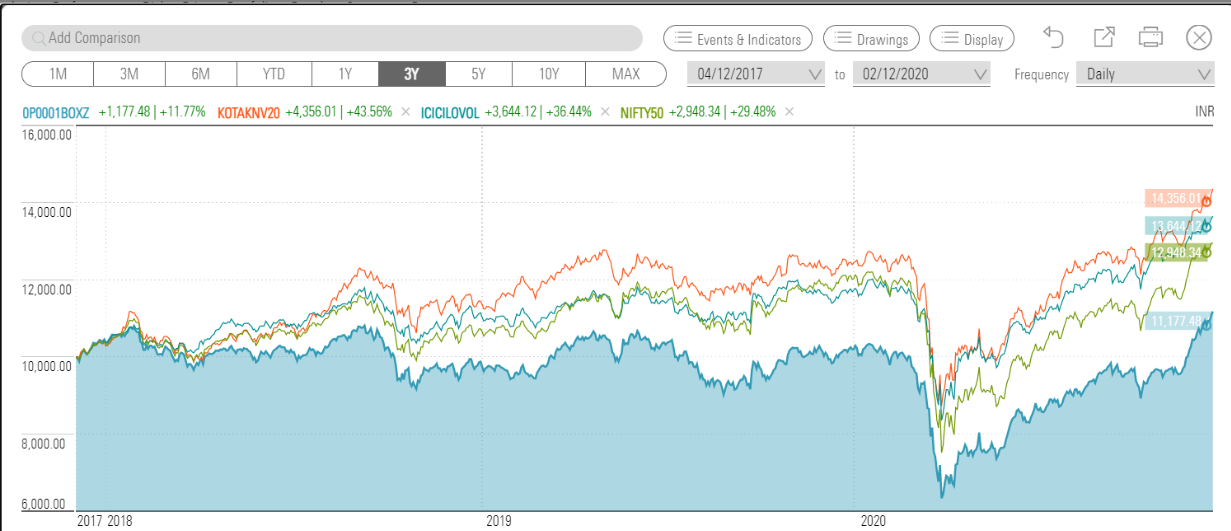
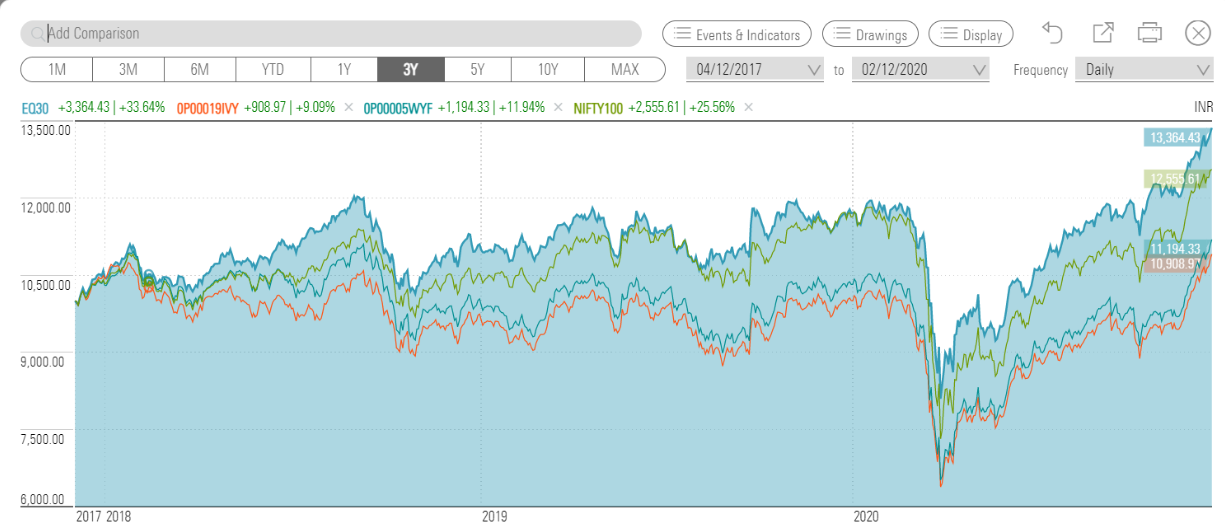




 Manikaran Singal is the founder and Chief financial planner at Good Moneying Financial Solutions. He is a CERTIFIED FINANCIAL PLANNER CM and SEBI registered Investment adviser (Regd no. INA 100001620). He’s having 20+ years of experience in financial services space.
Manikaran Singal is the founder and Chief financial planner at Good Moneying Financial Solutions. He is a CERTIFIED FINANCIAL PLANNER CM and SEBI registered Investment adviser (Regd no. INA 100001620). He’s having 20+ years of experience in financial services space.

